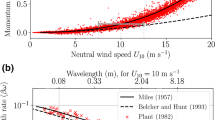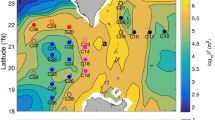Abstract
Babanin and Haus (J Phys Oceanogr 39:2675–2679, 2009) recently presented evidence of near-surface turbulence generated below steep non-breaking deep-water waves. They proposed a threshold wave parameter a 2ω/ν = 3,000 for the spontaneous occurrence of turbulence beneath surface waves. This is in contrast to conventional understanding that irrotational wave theories provide a good approximation of non-wind-forced wave behaviour as validated by classical experiments. Many laboratory wave experiments were carried out in the early 1960s (e.g. Wiegel 1964). In those experiments, no evidence of turbulence was reported, and steep waves behaved as predicted by the high-order irrotational wave theories within the accuracy of the theories and experimental techniques at the time. This contribution describes flow visualisation experiments for steep non-breaking waves using conventional dye techniques in the wave boundary layer extending above the wave trough level. The measurements showed no evidence of turbulent mixing up to a value of a 2ω/ν = 7,000 at which breaking commenced in these experiments. These present findings are in accord with the conventional understandings of wave behaviour.







Similar content being viewed by others
References
Agrawal Y, Terray E, Donelan M, Hwang P, Williams A, Drennan W, Kahma K, Kitaigorodskii S (1992) Enhanced dissipation of kinetic energy beneath surface waves. Nature 359:219–220
Anis A, Moum J (1995) Surface wave-turbulence interaction: Scaling ε (z) near the sea surface. J Phys Oceanogr 25:2025–2045
Ardhuin F, Jenkins A (2006) On the interaction of surface waves and upper ocean turbulence. J Phys Oceanogr 36:551–557
Babanin A (2006) On a wave-induced turbulence and a wave-mixed upper ocean layer. J Phys Oceanogr L20605(33):1–6
Babanin A, Haus B (2009) On the existence of water turbulence induced by non-breaking surface waves. J Phys Oceanogr 39:2675–2679 (Notes and Correspondence)
Bradshaw P (1971) An introduction to turbulence and its measurement. Pergamon Press, First edition
Burchard H, Craig P, Gemmrich J, van Haren H, Mathieu P, Meier H, Smith W, Prandke H, Rippeth T, Skyllingstad E, Smyth W, Welsh D, Wijesekera H (2008) Observational and numerical modeling methods for quantifying coastal ocean turbulence and mixing. Prog Oceanogr 76–4:399–442
Chang K, Liu P (1999) Experimental investigation of turbulence generated by breaking waves in water of intermediate depth. Phys Fluids 11–11:3390–3400
Chang K, Liu P (2000) Pseudo turbulence in PIV breaking-wave measurements. Exp Fluids 29:331–338
Cheung T, Street R (1988) The turbulent layer in the water at an air-water interface. J Fluid Mech 194:133–151
CEM, Coastal Engineering Manual (2008) US Army Corps of Engineers, Washington, DC (in 6 volumes)
Craig P, Banner M (1994) Modelling wave-enhanced turbulence in the ocean surface layer. J Phys Oceanogr 24:2546–2559
Drazen D, Melville W (2009) Turbulence and mixing in unsteady breaking surface waves. J Fluid Mech 628:85–119
Fenton J (1985) A fifth-order stokes theory for steady waves. J Waterw Port Coast Ocean Eng 111(2):216–234
Gemmrich J, Farmer D (2004) Near-surface turbulence in the presence of breaking waves. J Phys Oceanogr 34:1067–1086
Hughes S (1993) Physical models and laboratory techniques in coastal engineering. Advanced Series on Ocean Eng, vol 7. World Scientific Publications, Singapore
Jahne B, Haußecker H (1998) Air-water gas exchange. Annu Rev Fluid Mech 30:443–468
Janssen P (2004) The interaction of ocean waves and wind. Cambridge University Press, Cambridge
Jiang L, Perlin M, Shultz W (1998) Period tripling and energy dissipation of breaking standing waves. J Fluid Mech 369:273–299
Kinsman B (1984) Wind waves, their generation and propagation on the ocean surface. Dover publications, Inc., New York
Longuet-Higgins M (1953) Mass transport in water waves. Phil Trans R Soc Lond A 245:535–581
Longuet-Higgins M (1960) Mass transport in the boundary layer at a free oscillating surface. J Fluid Mech 8:293–306
Magnaudet J, Thais L (1995) Orbital rotational motion and turbulence below laboratory wind water waves. J Geophys Res 100(C1):757–771
Matlab® R (2010a)
Nikora V, Goring D (1998) ADV Measurements of turbulence: Can we improve their interpretation? JHydr Eng ASCE 124–6:630–634
Peirson W (1997) Measurement of surface velocities and shears at a wavy air-water interface using particle image velocimetry. Exp Fluids 23:427–437
Peregrine D, Svendsen L (1978) Spilling breakers, bores and hydraulic jumps. In: Proceedings of the 16th international conference on coastal engineering, 2nd edn., vol 1, pp 540–550
Phillips O (1961) A note on the turbulence generated by gravity waves. J Geophys Res 66–9:2889–2893
Rapp R, Melville W (1990) Laboratory measurements of deep water breaking waves. Philos Trans R Soc A 331:735–800
Reynolds O (1883) An experimental investigation of the circumstances which determine whether the motion of water shall be direct or sinuous, and of the law of resistance in parallel channels. Phil Trans R Soc Lond 174:935–982
Sheng J, Meng H, Fox R (2000) A large eddy PIV method for turbulence dissipation rate estimation. Chem Eng Sci 55:4423–4434 (Pergamon-Elsevier Science Ltd)
Siddiqui K, Loewen M (2007) Characteristics of the wind drift layer and microscale breaking waves. J Fluid Mech 573:417–456
SPM84, Shore Protection Manual (1984) 4th edn., 2 vol. US Army Engineer Waterways Experiment Station US Government Printing Office, Washington, DC
Stokes G (1847) On the theory of oscillatory waves. Trans Cambr Philos Soc 8:441–455
Swan C (1990a) Wave kinematics within the crest to trough region. Environ Forces offshore Struct Predict 26:45–60
Swan C (1990b) Convection within an experimental wave flume. J Hydraul Res 28:273–282
Teixeira M, Belcher S (2002) On the distortion of turbulence by a progressive surface wave. J Fluid Mech 458:229–267
Tennekes H, Lumley J (1972) A first course in turbulence. 15th printing MIT Press Design Department, Cambridge
Terray E, Donelan M, Agrawal Y, Drennan W, Kahma K, Williams A III, Hwang P, Kitaigorodskii S (1996) Estimates of kinetic energy dissipation under breaking waves. J Phys Oceanogr 26:792–807
Tolman H (2009) User manual and system documentation of WAVEWATCH III TM version 3.14. Technical note. MMAB Contribution No. 276. NOAA
Voulgaris G, Trowbridge J (1998) Evaluation of the acoustic Doppler velocimeter (ADV) for turbulence measurements. J Atmos Ocean Technol 15:272–289
Wiegel R (1964) Oceanographical engineering. Prentice Hall International in Theoretical and Applied Mechanics. N. M. Newmark editor, Englewood Cliffs
Author information
Authors and Affiliations
Corresponding author
Appendix
Appendix
Rights and permissions
About this article
Cite this article
Beyá, J.F., Peirson, W.L. & Banner, M.L. Turbulence beneath finite amplitude water waves. Exp Fluids 52, 1319–1330 (2012). https://doi.org/10.1007/s00348-011-1254-4
Received:
Revised:
Accepted:
Published:
Issue Date:
DOI: https://doi.org/10.1007/s00348-011-1254-4







